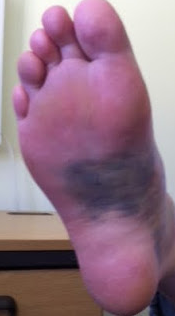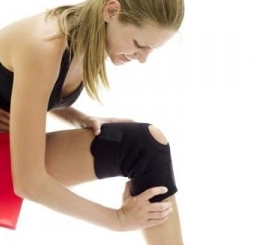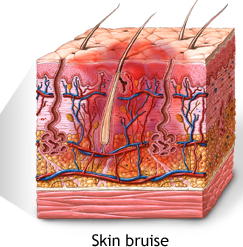Can you bruise your sternum? What are some of the symptoms associated with bruised sternum? What about treatment options and home care remedies that can help you improve the symptoms and promote healing? Here is an in-depthcoverage of all that and more.
Can You Bruise Your Sternum?
Just the other day, I saw a reader ask, “Can you bruise your sternum?” perhaps concerned that it could be the result of his/her symptoms.
The answer to this question is, yes, you can indeed get a bruised sternum given its protective role; it connects to the rib bones via cartilage with which they constitute the anterior section of the rib cage which serves the role of protecting the thymus gland, heart, lungs, and major blood vessels (aorta and vena cava) from any trauma.
Otherwise known as sternum contusion, bruised sternum is usually the result of trauma to the sternum (breastbone) and is commonly associated with automobile accidents e.g. when a driver’s chest is rammed into the steering column of the car on impact in a car accident.
Contact sports such as rugby, football, and boxing and sports that involve using of hard balls and rackets e.g. hockey can also impact the sternum leading to bruising.
Hacking coughs can as well cause bruising of the sternum since the forceful and violent nature of such coughs can place pressure on the sternum and eventually cause bruising if they continue for some time.
Bruised Sternum Symptoms
It is important to respond promptly as soon as bruised sternum symptoms are experienced to prevent from worsening and encourage quick healing. Very severe symptoms, especially pain, may also be a sign of more severe damage to the breastbone e.g. a sternum fracture.
Here are some of the symptoms associated with bruised sternum:
- Pain on the breastbone when breathing or moving
- Sharp pain when laughing or coughing
- Tenderness (on the front area of the chest)
- Swelling
- Bruising on the skin along the breastbone
- Prolonged chest pains (may last for weeks)
People who have sustained a bruised sternum tend to take small, shallow breaths as they try to lessen the pain. That may offer momentary relief in some cases, but bruised sternum symptoms should not at all be ignored as doing that can encourage the shallow breathing which eventually lead to serious lung infections.
Bruised Sternum Pain
Bruised sternum is typically associated with pain when breathing, laughing, coughing, or making a body movement e.g. bending. Bruised sternum pain varies depending on the extent of the injury but is can be particularly excruciating leading to shallow breaths as the person ailing tries to lessen the pain.
Bruised sternum pain responds well to treatment with micro-current therapy and anti-inflammatory drugs such as ibuprofen. Taking Bromelain supplements can as well help to relieve the pain associated with injured sternum. These options are discussed in more details in a subsequent section of this article.
Bruised Sternum Treatment
A bruised sternum takes between 4 and 6 weeks to heal (assuming only minor or moderate injury was sustained) during which the patient will experiencedifficultyin breathing and movement due to pain.With appropriate bruised sternum treatment however, the healing time can be shorted remarkably; to as low as 1-4 weeks.
Here are the two most common bruised sternum treatment options:
Micro-current Therapy: As the name suggests, this procedure entails using electric current to help repair the damaged tissues and lessen the pan associated with bruised sternums. The bruised area of chest is typically exposed to a small amount of electric current. The devices used are designed to correct the body’s electrical fields that have been disrupted as a result of the traumatic injury.
Medications: Anti-inflammatory medications including Non-Steroid anti-inflammatory Inflammation Drugs (NSAIDs) such as ibuprofen (commonly sold as Advil or Motrin); aspirin; and acetaminophen (Tylenol) can also be used to cut down on the pain associated with bruised sternums.
In addition to pain, some medications like ibuprofen will as well help to reduce swelling. Keep in mind however that aspirin is not recommended for children aged below 16 years. It has been linked to a rare but fatal medical condition called Reye’s syndrome.
Before embarking on treatment of bruised sternum, the doctor may advise that you have an X-ray done to ascertain that you have not sustained a sternum fracture.
How to Heal a Bruised Sternumwith Home Remedies
Breast bone injuries take longer to heal on a general scale and as we have already mentioned, 4-6 weeks are required before the bruised sternum can completely heal. During this time it’s advisable to take lots of rest and avoid any physical activities that involves lifting heavy objects.
Several home remedies have also been shown to speed up healing and for those of you asking how to heal a bruised sternum with home and natural remedies, here we go:
Cold compresses: Applying cold compresses is one of the best ways to reduce swelling on the bruised sternum. Simply take some ice cubes or frozen peas, wrap them in a small cloth or towel, and pat the bruised area with it gently for 5-10 minutes three times a day. You may hear some people refer to this remedy as “ice massage”.
A WORD OF CAUTION THOUGH: Never place the ice cubes directly on the skin as this may damage the skin.
Bromelain and vitamins C and K supplements: Fresh pineapples has been shown to reduce swelling and bruising attributed to bruising of sternum by providing essential digestive enzymes. Bromelain supplements, available in most health food stores, also has a similar effect on bruising and swelling as well as pain.
It also helps to take vitamin C and K supplements. As essential co-factors for various processes in the body, these vitamins have been shown to reduce bruise healing time considerably.
Low impact exercises: Some experts also recommend engaging in low impact such as biking and swimming as soon as symptoms have receded to not only restore your range of motion, but also reduce muscle stiffness. It is however advisable to talk to your doctor and get a go ahead before participating in such activities to avoid aggravating your condition.
In addition you will want to:
- Observe a healthy diet with lots of fruits and vegetables
- Avoid lifting heavy objects and repetitive movements that put stress on the breastbone area
- Avoid smoking. This will cut down the healing time considerably by ensuring proper circulation.
 eTopical Precious Finds
eTopical Precious Finds




